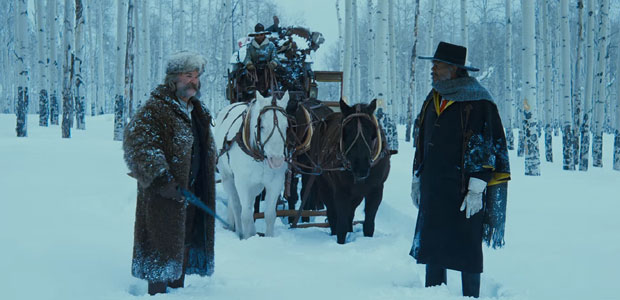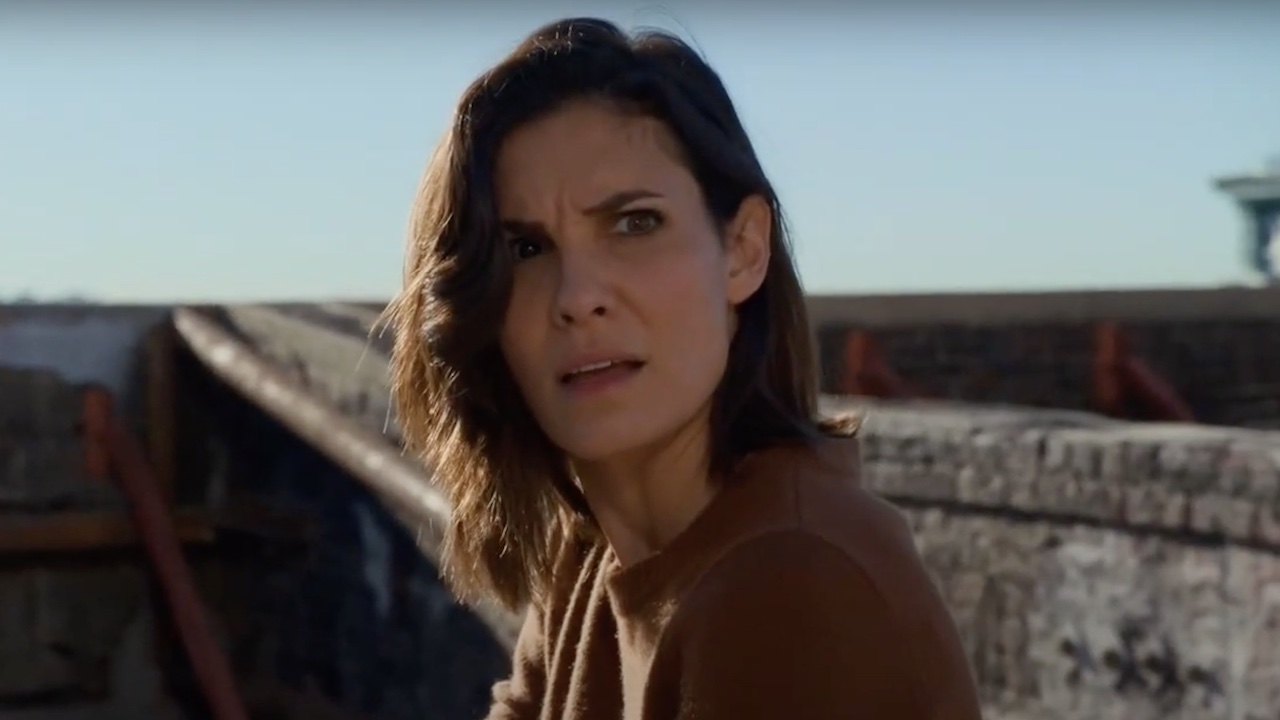The Hateful Eight is a completely different film than what Quentin Tarantino has been making in the last 12 years. After the hiatus that followed the release of Jackie Brown, the auteur found his career moving towards what could be described as more “epic” movies; and by employing his tremendous cinematic knowledge of great westerns, war flicks and kung fu features, he delivered large-scale mythical stories like Django Unchained, Inglourious Basterds, and the two-part Kill Bill. In contrast, The Hateful Eight is a return to his small-scaled, dialogue-heavy, non-linear storytelling, bloody, shocking origins, and, quite simply, it’s one of his best films.
When I say “origins,” I’m naturally referencing Reservoir Dogs - the 1992 debut that introduced the world to Tarantino and spellbound us with engrossing conversation, all while most of the action took place within the walls of a dinky, drab warehouse. The Hateful Eight is a brilliant return to this kind of storytelling, and with a combination of vile and captivating characters and ever-rising tension, it comes together as a classic-feeling, wholly-entertaining ride. It’s an immensely challenging narrative style, but there’s not a moment in the 187-minute runtime that you don’t feel completely enraptured in the events.
The key to any story like this, be it Reservoir Dogs, The Thing, or Who’s Afraid of Virginia Woolf?, is gathering a diverse group of personalities together and raising the heat on them until their ready to boil over – and with the racial tensions and divisiveness of the post-Civil War era in its back pocket, The Hateful Eight does exactly that. It begins with a confrontation on a snowy road between two bounty hunters. John Ruth (Kurt Russell), traveling with a prisoner named Daisy Domergue (Jennifer Jason Leigh), is unsure if should give a ride to Major Marquis Warren (Samuel L. Jackson), who is hitchhiking with a pile of bodies as his baggage. It’s that lack of trust that carries on as the theme through the entire rest of the film, as these three individuals eventually find themselves taking shelter from a blizzard in a haberdashery filled with shady characters.
After getting to know the various people with whom he’s found himself entrenched, Ruth declares that he knows at least one person in the group is working with Daisy and is going to try and set her free – and while he seems to be working with no proof or even evidence, a simple look around the room helps you recognize the brash, arrogant bounty hunter’s suspicions. Between the menacingly quiet cowboy Joe Gage (Michael Madsen), the intensely bigoted Confederacy General Sandy Smithers (Bruce Dern), and the former Rebel Renegade-turned-supposed Sheriff Chris Mannix (Walton Goggins), most of the folks in the establishment don’t immediately come across as honest. Even the British hangman Oswaldo Mobray (Tim Roth) and the substitute proprietor running the haberdashery, Bob (Demian Bichir), aren’t above suspicion. Understanding that the wolf in sheep’s clothing won’t reveal himself until the storm passes and the snow stops, Ruth works to uncover the secrets being held, all while the rest of the group hash out their own personal connections and estrangements.
All of these spiteful, horrible people have spiteful, horrible things to say to one another, and it’s really a glorious thing to bathe in three-plus hours of Tarantino-scripted dialogue. The writer/director’s darkly humorous wit is still as sharp as it was back in the early 1990s, and The Hateful Eight uses words to delight and hypnotize in equal measure. The filmmaker clearly had most, if not all, of his cast in mind while penning the screenplay, and paired with perfect performances, every character memorably pops and has the chance to either make us laugh or shake us to our core, armed with their own unique perspectives, backgrounds and deliveries. They have the kind of conversations you could listen to for days. They are engaging and exciting on the same level as all the bloodshed eventually unfolds in the latter half of the movie.
Quentin Tarantino is known for bringing out the best in the actors that he collaborates with, and The Hateful Eight only enhances that reputation, as the ensemble of veterans and newbies to the director’s work all deeply fall into the world and their respective roles. Kurt Russell is brilliant as the brash, bullish John Ruth. Jennifer Jason-Leigh’s Daisy is as venomous and awful as they come. And Walton Goggins is amazing as the doesn’t-know-when-to-shut-up Chris Mannix. Walking away from the film, though, it’s Samuel L. Jackson who audiences will be thinking about. Whether he’s playfully seducing John Ruth with a letter he received from President Abraham Lincoln, or delivering an extended monologue explaining how he knows General Sandy Smithers, Major Marquis Warren is captivating at every moment, and when he’s on screen, you’re looking nowhere else. It’s the biggest role that Jackson has had in a Tarantino movie since Jackie Brown, and it’s arguably his best yet.
The Hateful Eight screenplay is one of the best that Quentin Tarantino has ever scripted, but what’s almost intimidating is the fact that the guy is just as talented a director as he is a screenwriter – and in addition to being utterly captivating, the winter-set western is also jaw-droppingly gorgeous. The director and cinematographer Robert Richardson shot the movie using Ultra Panavision 70 lenses – the exact same used by William Wyler on Ben-Hur - and the result is a beautifully wide screen that the film utilizes with each shot. This is not only the case for the stunning sequences set out in the blizzard-struck outdoors, but even the interior events – adding to the paranoid atmosphere as your eye can explore the haberdashery from wall to wall. This comes in addition to all of Tarantino’s typical aesthetic flourishes – from long one-takes, to shots that travel above the characters and through the ceiling - and together create one of the filmmaker’s most visually fascinating features.
Being as big a fan as I am of Quentin Tarantino’s work, I walk into each of his movies with excessively high expectations – and while that can be a recipe for disappointment, I walked out of The Hateful Eight with a smile so wide it made my cheeks hurt. The writer/director’s latest delivers everything that fans love about his work, and is a wonderful cinematic experience that will be eagerly revisited time and time again in the future.

Eric Eisenberg is the Assistant Managing Editor at CinemaBlend. After graduating Boston University and earning a bachelor’s degree in journalism, he took a part-time job as a staff writer for CinemaBlend, and after six months was offered the opportunity to move to Los Angeles and take on a newly created West Coast Editor position. Over a decade later, he's continuing to advance his interests and expertise. In addition to conducting filmmaker interviews and contributing to the news and feature content of the site, Eric also oversees the Movie Reviews section, writes the the weekend box office report (published Sundays), and is the site's resident Stephen King expert. He has two King-related columns.











